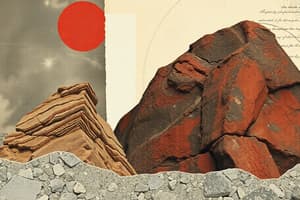Podcast
Questions and Answers
What are the three high-level rock categories defined in geology?
What are the three high-level rock categories defined in geology?
- Igneous rocks, sedimentary rocks, and metamorphic rocks (correct)
- Volcanic rocks, sedimentary rocks, and metamorphic rocks
- Igneous rocks, sedimentary rocks, and shale
- Igneous rocks, sandstone, and metamorphic rocks
What determines the category of a rock?
What determines the category of a rock?
- The age of the rock
- The color of the rock
- The size of the rock
- How the rock type forms (correct)
What is a key point in the definition of metamorphic rocks?
What is a key point in the definition of metamorphic rocks?
- The transformation happens in the solid state (correct)
- The transformation involves melting the rock
- The transformation is caused by erosion
- The transformation occurs in the liquid state
What are the two most common types of metamorphism?
What are the two most common types of metamorphism?
According to the principles of thermodynamics, what do all things try to reach?
According to the principles of thermodynamics, what do all things try to reach?
What is the term used for the preexisting rock that experiences metamorphism?
What is the term used for the preexisting rock that experiences metamorphism?
How do metamorphic rocks form?
How do metamorphic rocks form?
What are the examples of common protolith and resulting metamorphic rock?
What are the examples of common protolith and resulting metamorphic rock?
What causes the change in crystal structure from limestone to marble?
What causes the change in crystal structure from limestone to marble?
What distinguishes contact metamorphic rocks?
What distinguishes contact metamorphic rocks?
What is the primary heat source for contact metamorphism?
What is the primary heat source for contact metamorphism?
What distinguishes regional metamorphic rocks?
What distinguishes regional metamorphic rocks?
What causes the formation of regional metamorphic rocks?
What causes the formation of regional metamorphic rocks?
What is the difference in the scale of occurrence between contact and regional metamorphism?
What is the difference in the scale of occurrence between contact and regional metamorphism?
What are examples of common regional metamorphic rocks?
What are examples of common regional metamorphic rocks?
Flashcards are hidden until you start studying
Study Notes
Rock Categories
- Geology defines three high-level rock categories: Igneous, Sedimentary, and Metamorphic rocks.
Metamorphic Rocks
- Metamorphic rocks are defined as rocks that have changed from their original form due to heat, pressure, and chemical reactions.
- A key point in the definition of metamorphic rocks is that they do not melt during the transformation process.
- The two most common types of metamorphism are contact metamorphism and regional metamorphism.
Thermodynamics
- According to the principles of thermodynamics, all things try to reach a state of lower energy or equilibrium.
Metamorphic Rock Formation
- Metamorphic rocks form when a preexisting rock, called the protolith, experiences metamorphism.
- The protolith can be any type of rock, and it undergoes changes in mineral composition, structure, or texture due to heat, pressure, and chemical reactions.
- Examples of common protolith and resulting metamorphic rock include:
- Limestone → Marble
- Shale → Slate
- Basalt → Eclogite
Contact Metamorphism
- Contact metamorphism occurs when magma intrudes into a rocks, causing a localized change in temperature and pressure.
- This type of metamorphism is characterized by a distinct change in crystal structure, such as the transformation from limestone to marble.
- Contact metamorphic rocks are distinguished by their distinctive mineral assemblages and textures.
- The primary heat source for contact metamorphism is the magma.
Regional Metamorphism
- Regional metamorphism occurs when rocks are subjected to increased pressure and temperature over a large area, such as during mountain-building events.
- This type of metamorphism is characterized by a gradual change in mineral composition and structure over a large area.
- Regional metamorphic rocks are distinguished by their widespread distribution and uniform mineral assemblages.
- The formation of regional metamorphic rocks is caused by the movement of tectonic plates.
- Regional metamorphism occurs on a much larger scale than contact metamorphism.
Examples of Regional Metamorphic Rocks
- Examples of common regional metamorphic rocks include quartzite, schist, and gneiss.
Studying That Suits You
Use AI to generate personalized quizzes and flashcards to suit your learning preferences.




